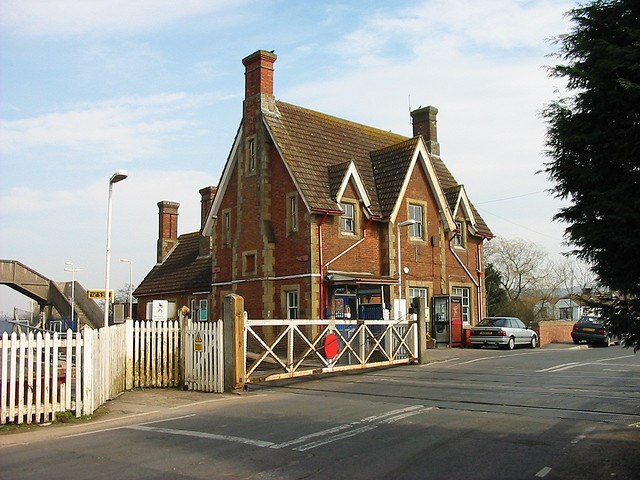
This is an attractive rural station, which retains much of its bygone charm. The site has managed to avoid drastic rationalisation and modernisation – until fairly recently, not only did the station boast 19th Century buildings and manually-operated level crossing gates, but also comprised a working signal box and a full complement of semaphores. Wye came into use on 6th February 1846, opening with the Ashford to Canterbury section of the SER’s branch to Margate. The company received Royal Assent for its Thanet via Canterbury line on 23rd May 1844, and secured £400,000 in shares and £133,000 in the form of loans to cover the route’s construction cost. In its fledgling years, the SER provided very little in the form of station infrastructure, and being one of the company’s earlier openings, Wye probably consisted of little more than platform surfaces. These in turn would merely have been a series of wooden planks, simply bridging the gap between ground level and the floor of the carriages. A more permanent-looking affair here probably evolved over the subsequent ten years, the station developing into a somewhat untypical creation of the SER.
Two platforms eventually came into use, lined at their rears with iron railings, and contrary to SER practice at the time – particularly at rural sites – these were not staggered. The main building was a somewhat grand affair, positioned at the southern end of the ‘’up’’ platform. It was two-storeys high, built in red brick, lined at the edges with stone, and demonstrated a series of gabled pitched roof sections. Of those stations upon the Ashford to Minster (exclusive) section of line, only Wye and Grove Ferry boasted such elaborate structures, each being a slight variation of a standard design. A scaled-down version of this same architecture was used for Crossing Keepers’ houses at both of these sites, and at the latterly opened Chartham. The level crossing at Wye was located immediately south of the platforms, and was flanked to the west and east by the aforementioned Keeper’s house and a gate box respectively. With reference to the latter, this was a diminutive single-storey clapboard affair, comprising a slated pitched roof and the SER’s trademark sash-style windows. It is likely that this came into use during the mid-1860s as the station’s first signal box, at a time when signalling nationwide was still in its primitive stages. More clapboard was also to be seen upon the ‘’down’’ platform, where an attractive 30-foot-long waiting shelter, complete with wrap-a-round sides, windows, and a backward-sloping roof, was provided.
Wye Racecourse had come into being, initially for flat racing, in 1849, the first meeting being held on 29th May of that year. Steeplechases were held in September, January, March, and May, and the oval course, less than a mile in length, was located 600 yards south of the station. At SER site, a third platform surface, dedicated to race day passenger traffic, was provided, immediately south of the level crossing. The racecourse track was to be found on the ‘’down’’ (west) side of the line, but conversely, the racecourse platform was built on the ‘’up’’ side of the line. Beside the ‘’down’’ track existed the Crossing Keeper’s residence and a ‘’home’’ semaphore, whilst the land alongside the ‘’up’’ track was without any significant obstacle, perhaps explaining the location choice of the third platform.
The Southern Railway installed its trademark swan-neck lampposts, complete with ‘’Target’’ name signs, but little else changed at Wye under this company’s reign. It was the British Railways era, particularly the period of the Kent Coast Electrification Scheme, which brought moderate infrastructure alterations. These began in 1960, with the installation of a 50-foot-span prefabricated concrete footbridge – a product of Exmouth Junction Works – between the platforms. This required the fitting of a banner repeater signal to the ‘’up’’ platform, now that the footbridge obscured the starter semaphore at the southern end of the layout. The platform surfaces themselves were re-faced with the same material, and the wrought-iron swan neck gasp lamps gave way to electric lighting, supported upon concrete bracket posts and demonstrating hexagonal lampshades. A regular electric service along the route commenced on 9th October 1961, but the full accelerated timetable on the ex-SER trunk line did not come into use until 18th June of the following year. Modernised colour light installations, controlled from a series of ‘’power boxes’’, came into use during the electrification programme on both Chatham and Tonbridge main lines, but the mechanical signalling of the Ashford to Hastings, Ashford to Minster, and Faversham to Dover Priory routes remained unaltered. Thus, Wye retained its Saxby & Farmer cabin, which continued to control a splendid array of semaphores, in addition to the sidings of the goods yard; the latter were formally decommissioned on 10th June 1963.
In about 1990, the distinctive concrete bracket lampposts were replaced by modern metal variants, and digital clock displays appeared on the platforms. At this time, traditional level crossing gates remained and these continued to be worked by hand. A lever frame was present at the southern end of the ‘’down’’ platform, which was used by the Crossing Keeper to release the gates. Semaphore signals were a feature of the station right up until the end of 2003: on 15th December of that year, colour aspect lights were commissioned in the vicinity, controlled from the ‘’Canterbury Wye Area Control Centre’’. The latter can be found at Canterbury West, in a modern portacabin affair located next to the gantry of the 1928-erected signal box. The Saxby & Farmer cabin at Wye was switched out of use, whilst the SER-designed signal box at Chartham was relegated to a gate box.